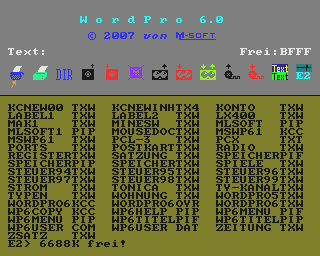- Details
- Geschrieben von Ralf Kästner
- Hauptkategorie: Network
- Veröffentlicht: 17. Mai 2009
- Zugriffe: 59063
The possibility exists certainly, several solutions are known for 8-bit systems.
TCP/IP
The following article gives a short overview and should not be exhaustive. I will show the problems of existing TCP/IP implementations and explain the advantages of the KCNet-interface for my needs in an usual home network.
In principle, this subject has interested me for long and I have pursued the development very carefully for many years. Since 1996 I use the internet, I built my first BNC home network with 5 PC's and a Linux softwarerouter behind the cable-modem 2002. Today I drive a Gigabit home network with its own network-server and VoIP-hardwarerouter with WLan.There are 8 PC's in the network, which has a 16-MBit ADSL-connection to the internet.
The only thing missing in the home network was my KC85 system!
If you want to build a network, you must know, how to do it. If it works, you want to know how the technology behind it operates. Sometime, you are interested in the software also and come to the TCP/IP stack inevitably. Then, you must work through a lot of theory and unfamiliar names and terms, before you understand how the components work with each other. Therefore, the following pictures summarize the most important things and concepts shortly.
There are masses of documents about this topic in the internet. Very good and extensive overviews can be found for example at:
| The TCP/IP Guide | http://www.tcpipguide.com/free/index.htm |
| IBM Redbook "TCP/IP Tutorial and Technical Overview" | HTML/Java version |
| Microsoft TechNet Library | TCP/IP Fundamentals for Windows |
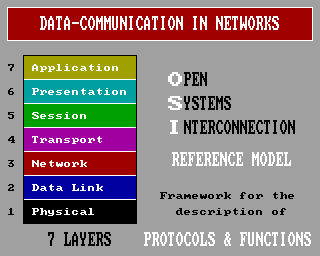
The OSI reference model is the fundamental networking model. It was published in 1984 by the ISO as standard ISO 7498. The model is a very useful tool for education and development. It defines a set of layers and a number of concepts for their use, that make understanding networks easier.
OSI splits the entire "network monster" in layers with individual tasks. Each of the modular components is responsible for a particular function. The particular function of one layer refers specifically to a set of communication rules, instructions and/or procedures. They describe the communication between specific software or hardware elements, running at the same layer on different machines within a network : the horizontal communication protocol of corresponding layers.
Interfaces are between the layered components for data transfers in both directions. Vertical communication is done up and down the protocol stack, every time anything is sent or received across the network. This occurs because the higher levels are implemented as logical functions in software. There is no actual physical connection.
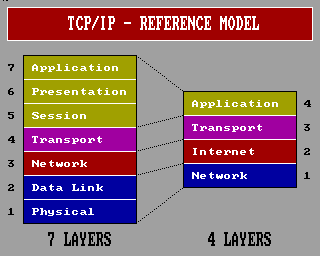
In the case of a TCP/IP network, the TCP/IP reference model is used in discussions of this suite. It has many similarities to the OSI model, but also some differences. TCP/IP in general, covers many layers of the OSI model and provide services to other protocols, as well as services provided to end users directly.
The protocol services consist of the core functions, implemented by the main TCP/IP protocols: IP, TCP and UDP. These services are designed to actually accomplish the internetworking functions of the protocol suite. The IP protocol provides functions at Internet layer 2, such as addressing, delivery and datagram packaging, fragmentation and reassembly. TCP and UDP are concerned at the Transport layer 3 with encapsulating user data and managing connections between devices. Higher layer protocols use these services, allowing them to concentrate, on what they are intended to accomplish.
The other general types of service provided by TCP/IP are end-user services. These facilitate the operation at the Application layer 4, like www, that users run to make use of the power of the Internet and other TCP/IP networks.
The function of the Network layer 1 and how it has to work, is not exactly spezified. It makes use of other existing protocols like Ethernet or Slip. The network layer protocol defines, how a host must be connected to a network for the transmission of IP-packets.
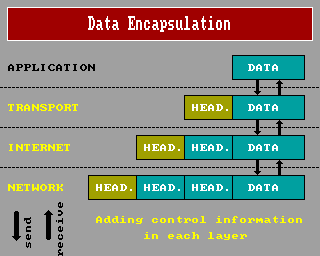
Data Encapsulation is the hell of data flow through the layers. Every layer protocol adds / removes its own information as header in front of (or footer behind) the data of the next upper or lower layer. The entire contents of the higher layer message are encapsulated as the data payload of the message at the lower layer.
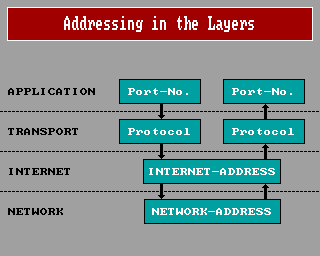
An Ethernet-based TCP/IP network needs 4 addresses to transport data, from the Ethernet-line up to the Application layer and vice versa. This is very confusing for beginners, but necessary to implement the OSI model with independent components:
- physical network address (MAC) on the network layer
- internet address (IP) on the internet layer
- transport protocol number on the transport layer
- port number on the application layer
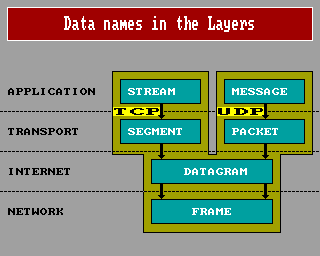
TCP/IP speaks its own language. Many terms there are for the unique identification of data in the individual layers. With such a specific term, it is clear where the data are in the TCP/IP stack, and what structures and contents they have. The picture shows the important terms for an Ethernet network.
- Zurück
- Weiter >>

